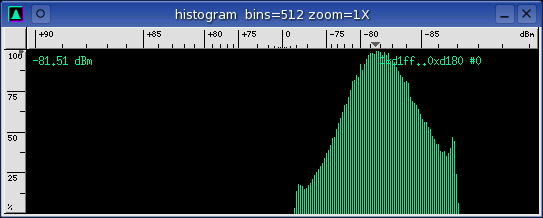We've got signal, but what the heck is it?
That's your mission. Analyze this bébé.

 download the audio file 7.wav.gz
download the audio file 7.wav.gz
hints :
- No need to gunzip this file since baudline can automatically uncompress
files.
-
Try playing the mystery signal at different speeds, slow it down or drop it
an octave.
-
Use baudline's
harmonic helper bars
to determine harmonic relationships.
- Use the
delta measurement bars
to measure pitch change.
-
Switch to a bigger FFT size to measure small changes in frequency.
-
This is not the sound of a big angry bubble bee.
What is it?
This mystery signal is the sound of the harmonic oscillations of a surf board
strapped to the roof of a rental car that is slowly accelerating.
There are two signals of interest here. Let's break it down.
The 4 cylinder rental car accelerates from about 30 MPH at the start to about
50 MPH at the end of the file. Switching to a 16384 point FFT size will
help bring out the detail. The first signal starts at 80 Hz and it slowly
increases in a linear fashion to 88 Hz at the 12 second mark. Using the
harmonic helper bars, the 3rd harmonic is the strongest, but the 2nd and 4th
are faintly visible. This is the sound of the car engine revving from 2400
to 2640 RPM. Then at the 12 second mark a transition that takes about 3/4
of a second occurs, this is the gear shift of the automatic transmission.
The new new fundamental is about 70 Hz and it slowly increases again in a
linear fashion to 74 Hz where the file ends. This equates to an increase
in engine rev speed from 2100 RPM to 2220 RPM. The acceleration was
slow and the RPM calculations match the behavior one would expect from a low
performance 4 cylinder rental car with an automatic transmission.
The second signal of interest starts at 128 Hz and time zero.
Things are fairly calm and the coupled surf board, springy strap, and rental
car roof-speaker-cone are just starting to hum and oscillate.
The harmonic helper bars show that the fundamental and the 2nd through the 6th
harmonic are all related. Tracking the wiggles of the fundamental over
time reveals that the variations match the harmonics perfectly.
As the car speeds up the lift and the wind force on the surf board increases
and the wild harmonic oscillations increase in strength and frequency.
There could be some chaos here, it looks like some bifurcation of modulation
modes are happening, but some further measurements and analysis is required to
say for sure.
This mystery signal was recorded on a Canon S110 digital camera in low
resolution movie mode. Baudline can read the Canon .AVI movie files and
automatically extract the audio. In 160x120 low res mode the S110 can
record for 30 seconds which which when coupled with baudline makes it an
excellent portable sound recording device. The Canon S110 sound samples
are 8-bit at a 11024 sample rate. Looking at the histogram you can see
the huge negative DC offset lopsidedness and that every other bin is zero.
The even odd bin holes show that the signal originally was 8 bit sampled.
The DC offset is most likely caused by a firmware bug in the camera.
In the frequency domain this DC offset equates to a strong 0 Hz tone which can
visually ignored or corrected with the
equalization window.

|
![]()